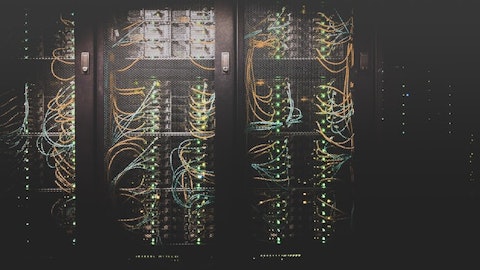Juniper Networks, Inc. (NYSE:JNPR) Q1 2023 Earnings Call Transcript April 25, 2023
Juniper Networks, Inc. beats earnings expectations. Reported EPS is $0.48, expectations were $0.43.
Operator: Greetings. Welcome to the Juniper Networks Q1 2023 Financial Results Conference Call. At this time, all participants are in a listen-only mode. A question-and-answer session will follow the formal presentation. Please note, this conference is being recorded. I will now turn the conference over to your host, Jess Lubert. You may begin.
Jess Lubert: Thank you, operator. Good afternoon, and welcome to our first quarter 2023 conference call. Joining me today are Rami Rahim, Chief Executive Officer; and Ken Miller, Chief Financial Officer. Today’s call contains certain forward-looking statements based on our current expectations. These statements are subject to risks and uncertainties, and actual results might differ materially. These risks are discussed in our most recent 10-K, the press release furnished with our 8-K filed today, the CFO commentary posted on the Investor Relations portion of our website today and in our other SEC filings. Our forward-looking statements speak only as of today, and Juniper undertakes no obligation to update any forward-looking statements.
Our discussion today will include non-GAAP financial results. Reconciliation information can be found on the Investor Relations section of our website under Financial Reports. Commentary on why we consider non-GAAP information a useful view of the Company’s financial results is included in today’s press release. Following our prepared remarks, we will take questions. We ask that you please limit yourself to one question so that as many people as possible who would like to ask a question have a chance. With that, I will now hand the call over to Rami.
Rami Rahim: Good afternoon, everyone, and thank you for joining us on today’s call to discuss our Q1 2023 results. We delivered better-than-expected results during the first quarter with total revenue of $1,372 million, growing 17% year-over-year and exceeding the midpoint of our guidance. Total product sales grew 23% year-over-year and we saw year-over-year growth across all customer solutions and all geographies. Profitability was also strong in Q1 as our non-GAAP gross and operating margin both exceeded expectations, resulting in non-GAAP earnings per share of $0.48, above the high end of our quarterly guidance range. These results reflect healthy customer demand for our solutions as well as the improvements we’re seeing in the availability of supply.
Our teams continue to execute extremely well, and we remain confident in our positioning from a technology, go-to-market and supply chain perspective, to capitalize on our customers’ digital transformation and cloudification initiatives that are likely to further increase network requirements over the next several years. As expected, total orders softened during the March quarter, declining more than 30% year-over-year. I do not believe this reflects true underlying demand due to our customers’ consumption that previously placed early orders and the reduced need for new early orders as lead times have improved. With that said, we believe customer ordering patterns are normalizing and we would expect to see a return to more traditional seasonal patterns on a sequential basis starting this quarter.
This would imply that our year-over-year order declines should improve on a go-forward basis, and return to year-over-year growth potentially as soon as Q4 of this year. From a vertical basis, I remain extremely encouraged by the momentum we’re seeing in our enterprise business, which grew nearly 30% year-over-year in Q1 with double-digit revenue growth in both the campus and branch and the data center. We also saw strong momentum in the channel where deal registration grew by more than 30% year-over-year, and in the commercial market, where orders grew by 40% year-over-year. As of the March quarter, the Enterprise accounted for more than 40% of our total revenue and represented both our largest and our fastest-growing vertical for a second consecutive quarter.
Our Enterprise campus and branch business performed exceptionally well in Q1 with revenue growing nearly 50% year-over-year. Our customers are clearly recognizing the value of our cloud-native AI-driven architecture, which helps them optimize user experiences from client to cloud and minimize operating costs through proactive automation. Revenue from the Mistified segment of our business, which is defined as products driven by Mist AI grew by nearly 60% year-over-year in the Q1 time frame with new logos increasing by nearly 30% year-over-year. Wi-Fi momentum continues to outpace the market and we are seeing record pull-through of wired switching as well as increased attach of our AI-driven SD-WAN offerings. Important wins this quarter included a top-tier U.S. bank, one of the largest U.S. retailers, a leading global logistics provider and a top pharmaceutical company just to name a few.
Not to be overlooked, our Apstra pipeline continued to build as new logos more than doubled on a year-over-year basis and we experienced strong hardware pull-through for every dollar of software, which we view as a positive indicator for our Enterprise data center prospects. Given our level of portfolio differentiation, balanced against our relatively modest share in the large markets where we compete, I expect us to grow both Enterprise revenue and orders during the year even in a more challenged macro environment. Our service provider business also performed well in Q1 due in large part to the timing of supply which enabled us to fulfill prior orders with some of our larger Tier 1 Service Provider customers, particularly for our MX and PTX platforms.
While revenue with these customers is likely to remain lumpy on a quarter-to-quarter basis, I’m optimistic about our ability to grow this business during the year based on the momentum we’re seeing around customer 400-gig wins, many of which remain large opportunities in the early stages of deployment. We also continued to see strong early interest in our cloud metro portfolio, led by our Paragon automation suite. In fact, our ACX7K platform saw another quarter of triple-digit year-over-year order growth. With further enhancements to this portfolio expected later this year and next, we expect momentum within this business to build through the year and become more material to revenue in 2024 and beyond. I’d like to acknowledge we continue to see accounts across each of our customer verticals, more closely scrutinizing budgets and project deployment time lines due to the macro uncertainties that are happening around the world.
While order cancellations continue to remain extremely low, as supply improves, we are seeing more customers reschedule delivery dates to better match current project time line. This is proving to be particularly true in the cloud vertical, where certain customers are digesting prior purchases, and we saw a series of projects pushed to future periods during the March quarter. While these delays may negatively impact our ability to grow our cloud business in the current year, based on the conversations we’ve had with many of these accounts, we’re confident these delays are a function of timing and remain positive regarding our long-term growth outlook in cloud. In summary, I remain confident in our strategy and optimistic regarding our ability to navigate market uncertainty.

SFIO CRACHO/Shutterstock.com
My enthusiasm is fueled by our continued Enterprise momentum, the success we’re seeing around Service Provider 400-gig deployments, the ongoing strength of our backlog which remains well above historical levels and the improvements we’re seeing in supply. Longer term, I continue to see attractive growth opportunities in the cloud, while we already maintain a meaningful footprint and remain closely engaged with many of these customers on potential new opportunities both in the wide area and the data center that could present additional growth drivers. Finally, I remain encouraged by the improved diversity of our business which is lessening our sensitivity to any one customer or vertical and enabling us to navigate pockets of weakness in the market by pivoting resources to the greatest areas of opportunities.
Based on these dynamics, coupled with our Q1 actuals and expectations for Q2, we are raising our full year revenue outlook and currently expect to deliver at least 9% growth for the year. We continue to remain focused on delivering improved profitability and expect to deliver greater than 100 basis points of operating margin improvement in 2023. I will now turn the call over to Ken who will discuss our quarterly financial results in more detail.
Ken Miller: Thank you, Rami, and good afternoon, everyone. I will start by discussing our first quarter results, then provide some color on our outlook. We ended the first quarter of 2023 with $1,372 million in revenue, above the midpoint of our guidance and up 17% year-over-year. We delivered non-GAAP earnings per share of $0.48, which is above the guidance range, driven by the higher-than-expected revenue and gross margin. From a customer solution perspective, we saw year-over-year revenue growth in all areas. AI-driven enterprise led the way with revenue growth of 48%, automated WAN solutions revenue grew 21% and cloud-ready data center revenue increased 3%. Looking at our revenue by vertical. On a year-over-year basis, Enterprise increased 29%, Service Provider increased 28% and Cloud decreased 14%.
Total software and related services revenue was $232 million, which was an increase of 2% year-over-year. Annual recurring revenue, or ARR, was $293 million and grew 39% year-over-year. Deferred revenue from our SaaS and software license subscriptions grew 68% year-over-year. We remain confident in our outlook for total software growth and ARR growth. Total security revenue was $182 million, up 13% from the first quarter of last year due to the timing of shipments related to improved supply. In reviewing our top 10 customers for the quarter, 5 were Service Providers, 4 were Cloud and 1 was an Enterprise. Our top 10 customers accounted for 30% of total revenue as compared to 32% in Q1 2022. Non-GAAP gross margin was 57.8%, which was above the midpoint of our guidance, primarily driven by favorable customer mix and higher revenue volume.
While supply has improved for the majority of our products, we continue to experience supply constraints for certain components and supply chain costs remain elevated. If not for those elevated supply chain costs, we estimate that we would have posted a non-GAAP gross margin of approximately 59%. Non-GAAP operating expenses increased 10% year-over-year and 3% sequentially, primarily due to headcount-related costs. Non-GAAP operating margin was 14.8% for the quarter, which was above our expectations, driven by higher revenue and better-than-expected gross margin. As Rami mentioned, bookings were down more than 30% year-over-year in the first quarter. As a reminder, in Q1 2022, we were still getting a lot of early orders as customers were dealing with supply constraints and extended lead times.
In Q1 2022, our product orders were over $1.1 billion. Now customers are consuming those early orders and are no longer placing early orders as supply constraints have improved and lead times are shortening. This combination is resulting in a year-over-year decline in bookings, which we expect to moderate going forward. Our backlog remains elevated but declined by more than $350 million due to improvements in supply and order patterns normalizing. Due to the continuation of these factors, we expect backlog to further decline in 2023, but remain elevated relative to historical levels exiting the year. Cash flows from operations was $192 million in the quarter. We paid $71 million in dividends, reflecting a quarterly dividend of $0.22 per share.
We also repurchased $140 million worth of shares in the quarter. We exited the quarter with total cash, cash equivalents and investments of approximately $1.2 billion. I’m very pleased with our financial performance in the first quarter. This is a testament to our team’s dedication and commitment to delivering excellence. Now, I would like to provide some color on our guidance which you can find detailed in the CFO commentary available on our Investor Relations website. At the midpoint of our guidance, we expect second quarter revenue of $1,410 million, which is 11% growth year-over-year. Our confidence is driven by the strength of our demand forecast, our elevated backlog and an improved supply outlook. Second quarter non-GAAP gross margin is expected to be approximately 58%.
We expect second quarter non-GAAP operating expenses to be flat sequentially. Turning to our expectations for the rest of 2023. With the order and backlog visibility we have and our current expectations for supply, we are raising our full year revenue guidance from at least 8% to at least 9% growth. This increase in our revenue expectation reflects the Q1 overachievement and the expectations embedded within our Q2 guidance. For the remainder of 2023, we expect to see sequential revenue growth more in line with normal seasonal patterns. However, the degree of seasonality will be impacted by availability of supply and the timing of customer requested delivery dates. We expect non-GAAP gross margin to slightly expand to approximately 58% in 2023.
This is above the prior guidance of flat to slightly up versus 57.4% in 2022. However, gross margin results will depend on revenue mix and the future trajectory of supply chain costs. With this in mind, we expect non-GAAP operating margin to expand by greater than 100 basis points on a full year basis. Our non-GAAP EPS is expected to grow double digits on a full year basis. Finally, I’m pleased to announce we have declared a quarterly cash dividend of $0.22 per share to be paid this quarter to stockholders of record. In closing, I would like to thank our team for their continued dedication and commitment to Juniper’s success, especially in this dynamic environment. Now, I would like to open the call for questions.
See also 11 Best Waste Management Stocks to Buy Now and 35 Most Beautiful Places In The World.
Q&A Session
Follow Juniper Networks Inc (NYSE:JNPR)
Follow Juniper Networks Inc (NYSE:JNPR)
Operator: Our first question is from Amit Daryanani with Evercore.
Amit Daryanani: I guess the question I really have is around the order decline that you’ve seen of about 30%. It’s obviously notable here. Could you just touch on what do the order trends look like across three segments? I suspect there’s some variance there. And then maybe just related to that, I think the backlog number right now might be around $1.6 billion, $1.7 billion. What do you think the normalized level looks like? What is — the normalized level is for backlog in a post-COVID world?
Ken Miller: Yes. So from an order decline perspective, I would want to remind you that it really is about the comparison. So a year ago, we were still receiving a lot of early orders, as I mentioned in my prepared remarks, a year ago, the orders were over $1.1 billion. Now what’s happening is customers are actually receiving those orders and are no longer placing early orders as lead times are now coming in. So, you’re really seeing last year the orders were actually greater than real demand, if you will. This year, as we normalize, they’re less than what I would say is real demand as they’re leveraging what they already booked and no longer booking early orders. So that’s why you’re seeing those year-on-year declines.
From a vertical perspective, we did see a slight decline in Enterprise, a very slight decline there. The majority of the client was in Service Provider and Cloud as those were the ones that were having the more normalization required compared to prior bookings. And I would say, in particular, in Q1, we did see Cloud was our weakest vertical from an orders perspective for some of the reasons that Rami mentioned in his prepared remarks. On the backlog perspective, we definitely expect to exit the year at elevated levels. I would say more than twice what we normally were from a backlog perspective pre-pandemic. So we used to be around $400 million, give or take, a little bit. I expect to exit north of $800 million, more than double normal levels as we close the year out.
Operator: The next question comes from Tim Long with Barclays.
Tim Long: I was hoping you could just dig into the cloud and the push-out there a little bit. Maybe one, just keeping on the orders, as those push out into later periods, what do you think impact that will have on future period orders? And then, anything you could tell us secondly on kind of products or technologies or any other tidbits on why these push-outs are happening? Is it just a straight digestion, do you think it’s happening across the board, or anything more in your pieces of the network with the larger players?
Rami Rahim: Yes. Let me take that, Tim. So first, I want to highlight that in Q1, what we saw mostly was a function of our ability to ship products that our customers in the Cloud segment wanted. Your question, I think, is more around sort of the demand dynamics in the Cloud. And on that, I’d say that there definitely is a bit more scrutiny of certain projects. There were some projects that did move out in time. It’s not specific to any one customer. It’s not even specific to the Tier 1 hyperscale cloud provider. I would say it’s a little bit broader than that. Having said all that, I want to emphasize that the projects that we have been engaged in around 400-gig upgrades, for example, data center interconnect, data center fabric, pluggable optics, DR, DR-plus type of use cases remain intact.
I mean, I have not seen project cancellations in cloud. I’ve only seen an adjustment in the timing of those projects, which is sort of impacting the demand environment in the Cloud segment. So I expect that that — sort of that impact to last for the next few quarters, but I do fully expect that it will recover.
Ken Miller: Yes. And from a revenue perspective, I’ll just reiterate what Rami said that the quarterly results is largely due to just timing of supply and timing of deployments. We do expect cloud revenue to recover from Q1 levels. I don’t think the Q1 levels for cloud is going to be the new norm. You saw a little bit of a shift from a supply and timing of projects towards Service Provider in Q1 with a large growth in Service Provider. Cloud was down more than expected in Q1. That will normalize as we proceed to burn through the backlog and demand.
Operator: The next question comes from Paul Silverstein with TD Cowen.
Paul Silverstein: Returning to this issue on customer delays and downsizing if not cancellations. Ken and Rami, hoping — I was hoping for some more insight, beyond Tim’s question, just focused on Cloud, what are you seeing over time and what are terms of those delays, the increased scrutiny, how severe is it and how does that compare to 90 days ago and how has it trended recently?
Rami Rahim: Okay. Paul, thanks. So I’m not sure if I can give you that much more color than I just provided. I’ll say that we started to see some of the delays early in the quarter. Like I said, I don’t think it’s specific to any one customer. The most important thing I want to highlight to you all is that I do not believe that this is permanent. So, if it was permanent then the projects that we are engaging in — when I say engaging in, I mean, in labs, testing specific features, capabilities, 400-gig density, power efficiency, all of these things that matter a lot to our cloud customers are still very much active. They are in motion. And so what we thought in terms of certain ramp for some projects has simply moved out in time. And by how much, it’s sort of difficult to know exactly, but I’d say sort of a few quarters. And I fully expect that the cloud demand environment is going to come back and if not by the end of this year, then next year.
Paul Silverstein: Rami, just to be clear, you specifically referenced cloud demand environment. But if we look beyond Cloud to Enterprise and carrier, is it the same comment?
Rami Rahim: Okay. Thank you, Paul. I actually didn’t catch that. I thought this was more around Cloud.
Paul Silverstein: No, it’s a broader question. Looking at the totality business, including Enterprise and Cloud.





